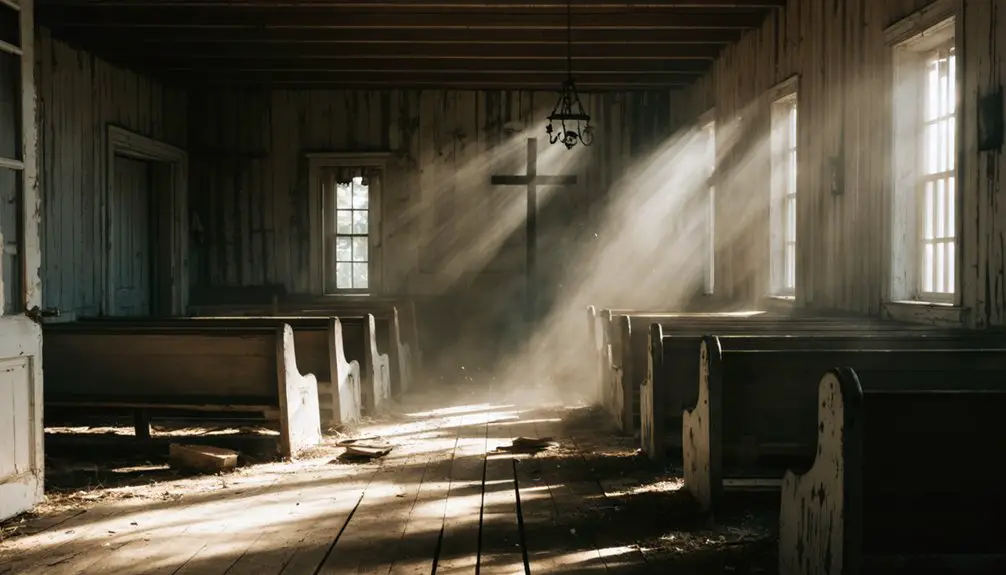You’ll find Citra nestled in Hughes County, Oklahoma, at an elevation of 721 feet, about 3 miles northwest of Wheeless. This former frontier town boomed after the Missouri-Kansas-Texas Railroad‘s arrival in 1870, with its post office opening in 1894. Like many Oklahoma settlements, Citra fell victim to changing economic tides, closing its post office in 1931. Today, only the cemetery and Dawson Chapel remain as silent witnesses to this once-bustling community’s fascinating story.
Key Takeaways
- Citra was established in Oklahoma’s Choctaw Nation during the late 1800s, with its post office opening in 1894 and closing in 1931.
- The town prospered initially due to the Missouri-Kansas-Texas Railroad, serving as a vital trade center for cattle drives and grain shipments.
- Located in Hughes County at coordinates N34.80481° W96.37722°, Citra sits 3 miles northwest of Wheeless at 721 feet elevation.
- Economic decline followed railroad abandonment, agricultural challenges, and population exodus as younger residents sought urban opportunities.
- Today, only the cemetery and Dawson Chapel church remain as historical markers of this once-thriving frontier settlement.
The Rise and Fall of Citra
Although little remains of Citra today, this Oklahoma Panhandle settlement once embodied the classic boom-and-bust cycle that defined many frontier towns of the late 19th century.
Like countless frontier settlements, Citra rose and fell with the rhythms of 19th-century Oklahoma, leaving only whispers of its existence.
Similar to many of Oklahoma’s estimated two thousand ghost towns, Citra represents another chapter in the state’s rich history of abandoned settlements.
You’ll find Citra’s story mirrors that of countless settlements that sprouted during the region’s economic booms, likely drawing its early prosperity from the railroad and agriculture.
The Citra culture thrived in the relatively ungoverned period before the 1890 Organic Act, when loose territorial laws allowed communities to establish themselves with minimal interference.
Local residents maintained order through vigilante justice and hired sheriffs to enforce community rules.
But like many of its neighbors, the town couldn’t sustain itself against mounting challenges. Changes in territorial laws, statehood regulations, and environmental hardships gradually eroded its population.
Today, ghost town tourism enthusiasts can explore what’s left of this once-promising settlement, where nature has reclaimed most traces of frontier ambition.
Location and Geographic Features
While most Oklahoma ghost towns have faded into obscurity, Citra’s precise location in Hughes County remains well-documented at coordinates N34.80481° W96.37722°.
You’ll find this forgotten community in the southwestern corner of the county, about 3 miles northwest of Wheeless, at an elevation of 721 feet above sea level.
The geographic isolation of Citra is evident in its rolling prairie landscape, typical of the Great Plains region. The cemetery’s significance as the last visible landmark serves as a silent indication to the community that once thrived here. The Dawson Chapel church stands just 1.7 miles away as another historic remnant. Modern technology allows visitors to view the site through three nearby webcams.
Today, you can explore the area’s continental climate and mixed terrain of grasslands and hardwood forests, though little remains of the original settlement except scattered traces beneath the reclaiming vegetation.
Historical Timeline and Settlement
You’ll find Citra’s roots in the late 19th century Indian Territory, where it emerged as a settlement within District 15 of the Choctaw Nation.
The town’s official establishment came with its post office in 1894, marking the beginning of a period that would see the community grow and establish itself as a frontier outpost. James Napoleon Yates served as the town’s first postmaster during these formative years.
Citra’s eventual decline paralleled many Oklahoma settlements, leading to the closure of its post office in 1931 and its ultimate transformation into one of Oklahoma’s nearly two thousand ghost towns. Like many communities of its era, Citra’s fate was influenced by economic booms and busts that shaped the region’s development.
Early Territory Settlement Days
Long before Citra emerged as a settlement, the Oklahoma territory witnessed an extraordinary tapestry of human occupation spanning thousands of years.
You’d find Native American tribes, including the Wichita and the Five Civilized Tribes, cultivating the fertile lands with maize, squash, and cotton.
When European influence arrived, French traders established posts throughout the region, marking the territory’s first non-Indigenous settlements.
The Plains Apache arrived between 1300 and 1500 CE, establishing a presence alongside existing tribes in the region.
The region underwent dramatic changes when the Run of ’89 opened nearly two million acres for settlement, transforming the landscape with new communities and homesteads.
Railroad and Growth Period
The arrival of the Missouri-Kansas-Texas Railroad (MKT) in 1870 transformed Oklahoma’s landscape from scattered settlements into a network of thriving communities.
You’d have witnessed the rapid economic development as the MKT pushed south, connecting military forts and opening new trade routes. The railroad’s impact reached far beyond simple transportation – it became the lifeline for cattle drives heading north and grain shipments moving south. The Gulf and Ship Island was later acquired by Illinois Central Railroad, further expanding the rail network in the region.
When federal restrictions eased in the mid-1880s, you’d have seen an explosion of rail construction. The rail network reached its peak with nearly 6,600 miles of track by 1920.
The St. Louis & San Francisco Railway, Atchison, Topeka and Santa Fe, and Chicago, Rock Island & Pacific all laid tracks through the territory.
These railways didn’t just move goods; they brought settlers, connected isolated communities, and turned small stops like Citra into bustling trade centers tied to global markets.
Population Decline Factors
While several Oklahoma towns managed to sustain growth through the early 1900s, Citra’s population began declining due to a perfect storm of economic and environmental challenges.
You’ll find that Citra’s fate was sealed by multiple factors: the abandonment of critical railroad lines that once served as the town’s lifeline, and shifting socio-cultural patterns that saw younger residents moving to urban areas for better opportunities.
Environmental challenges, including agricultural difficulties from soil depletion and drought, made it harder for farming families to sustain themselves.
The changing transportation landscape, particularly as highways bypassed the community, further isolated Citra from essential trade routes.
These combined pressures ultimately transformed this once-thriving railroad stop into another of Oklahoma’s ghost towns.
Architectural Remnants and Ruins

Scattered across Citra’s abandoned landscape, architectural remnants tell stories of a once-thriving Oklahoma community.
You’ll find deteriorating red brick schoolhouses and weathered commercial buildings that showcase early 20th-century vernacular architectural styles. The WPA-era structures, with their robust brickwork and functional design elements, stand as evidence of 1930s New Deal construction.
As you explore the ghost town, you’ll discover stone jail cells with deep foundations and commercial establishments reduced to roofless walls.
Nature’s reclaimed much of Citra, with farmland and vegetation embracing the structural decay of these historic buildings. The remaining shells of homes, displaying weathered clapboard siding, and partial foundations blend into the rural surroundings, while crumbling walls parallel old highways, marking what was once a bustling settlement.
Economic Forces Behind Abandonment
You’ll find Citra’s economic decline mirrors many Oklahoma ghost towns, where the depletion of oil fields triggered a devastating chain reaction of job losses and population exodus.
When key transportation routes bypassed the town, businesses lost their customer base, and essential services gradually relocated to larger neighboring communities.
The town’s fate was sealed as residents, especially younger generations, moved to urban centers offering more diverse employment opportunities beyond the boom-and-bust cycle of resource extraction.
Resource Depletion Impact
As Oklahoma’s natural resources dwindled during the early to mid-20th century, Citra’s fate mirrored countless other boomtowns that had sprung up around the state’s extractive industries.
You’ll find that resource extraction defined not just the town’s rise but its inevitable decline, as the depletion of local deposits left the community without its economic foundation.
The economic consequences rippled through every aspect of local life. When the primary resource became unprofitable to extract, you’d see businesses shuttering one by one.
Without jobs to sustain families, residents had no choice but to seek opportunities elsewhere. The town’s population plummeted by more than 80%, and the tax base crumbled.
With no alternative industries to fill the void, Citra’s remaining infrastructure fell into disrepair, marking its transformation into a ghost town.
Transportation Route Changes
While railroads initially brought life to Citra in the late 1800s, changes in transportation routes ultimately sealed its fate.
You can trace the town’s decline through a series of transportation impacts that left it increasingly isolated. When the St. Louis & San Francisco Railway depot was abandoned, Citra lost its crucial rail connection that had enabled both passenger travel and freight shipments.
The final blow came with major route realignments that bypassed the town entirely. As Interstate 44 carved new paths through Oklahoma’s landscape, traffic that once flowed through Citra’s streets disappeared.
Local businesses that depended on passing travelers – from gas stations to general stores – couldn’t survive without that steady stream of customers. Like many small towns of its era, Citra faded as newer, faster transportation corridors drew life away from its borders.
Population Migration Patterns
The economic forces that drove Citra’s abandonment tell a familiar story of boom-and-bust cycles in Oklahoma’s ghost towns.
You’ll recognize the pattern – when natural resources were discovered, population shifts brought waves of workers and their families to these rural communities. As resources depleted and agricultural markets changed, migration trends reversed dramatically, with residents seeking opportunities in larger urban centers.
- Local businesses couldn’t sustain themselves as the customer base shrank by 80% or more
- Mechanization of farming and ranching reduced the need for local labor
- The Great Depression and post-WWII industrialization drew people to cities
- Environmental challenges like drought made it harder for remaining residents to justify staying
The collapse of Citra’s economic foundation mirrors the broader story of rural depopulation that transformed Oklahoma’s landscape during the 20th century.
Exploring Citra Today
Modern-day visitors to Citra, Oklahoma will find themselves traversing rural backroads to discover what remains of this once-active settlement.
You’ll need to rely on GPS coordinates or local knowledge, as signage is minimal in this remote location. For ghost town photography enthusiasts, the site likely offers views of scattered ruins and building foundations, though nature has reclaimed much of the area.
If you’re interested in archaeological exploration, you might discover traces of early Oklahoma commerce and settlement life among the remaining structures.
Remember to come prepared, as you won’t find any facilities or services at the site. While interpretive materials are scarce, the townsite provides a raw, unfiltered glimpse into Oklahoma’s rural heritage and the boom-and-bust cycles that shaped its landscape.
Legacy in Oklahoma’s Ghost Town Heritage

Beyond the physical remnants you’ll find at Citra lies a deeper story that connects to Oklahoma’s rich tapestry of ghost towns.
Like many of its abandoned counterparts, Citra’s cultural significance stems from its role in the state’s dynamic past, where boom-and-bust cycles shaped communities.
Today, preservation efforts by local historical societies work to keep these stories alive, documenting the town’s heritage for future generations.
- Citra represents one of Oklahoma’s estimated 2,000 ghost towns, each telling unique tales of frontier life and economic change.
- The town’s abandonment mirrors broader patterns of population shifts due to changing infrastructure and resource depletion.
- Local museums and historical markers help visitors connect with Citra’s past.
- The site serves as a valuable case study for understanding Oklahoma’s settlement patterns and economic diversification.
Frequently Asked Questions
Were There Any Notable Crimes or Mysteries Associated With Citra’s History?
You won’t find any documented unsolved mysteries or significant criminal activity in the records. Like many Oklahoma ghost towns, its story reflects economic decline rather than notorious events.
What Native American Tribes Originally Inhabited the Land Where Citra Was Built?
You’ll find the Wichita and Caddo peoples were the primary tribes with deep tribal history in Citra’s land, while Osage, Pawnee, and other indigenous groups maintained cultural significance across the broader region.
Are There Any Local Legends or Ghost Stories About Citra?
You won’t find documented Citra legends or ghost sightings in the historical record. While the town’s cemetery remains, and Native American heritage runs deep, specific supernatural tales haven’t been preserved through time.
What Happened to the Residents After They Left Citra?
You’ll find Citra’s residents scattered to nearby towns, especially Holdenville, seeking better jobs during the Great Depression. Many joined established communities in Hughes County, while others left Oklahoma entirely.
Is Metal Detecting or Artifact Collecting Allowed at the Citra Site?
You’ll need permits and explicit permissions for metal detecting due to strict regulations. Without proper authorization, artifact collecting isn’t allowed as it violates preservation laws and can result in serious penalties.
References
- https://www.youtube.com/watch?v=5d-wHDTIbb0
- https://en.wikipedia.org/wiki/List_of_ghost_towns_in_Oklahoma
- https://okmag.com/blog/a-ghostly-site/
- https://pastmaps.com/explore/us/oklahoma/hughes-county/citra/hiking-exploration
- https://kids.kiddle.co/List_of_ghost_towns_in_Oklahoma
- https://www.youtube.com/watch?v=LUbwVR0z0nA
- https://www.youtube.com/watch?v=zTKa5i1czdE
- https://www.okhistory.org/publications/enc/entry?entry=GH002
- https://www.okhistory.org/historycenter/forms/timeline.pdf
- https://geotargit.com/index.php?qcountry_code=US&qregion_code=OK&qcity=Citra



